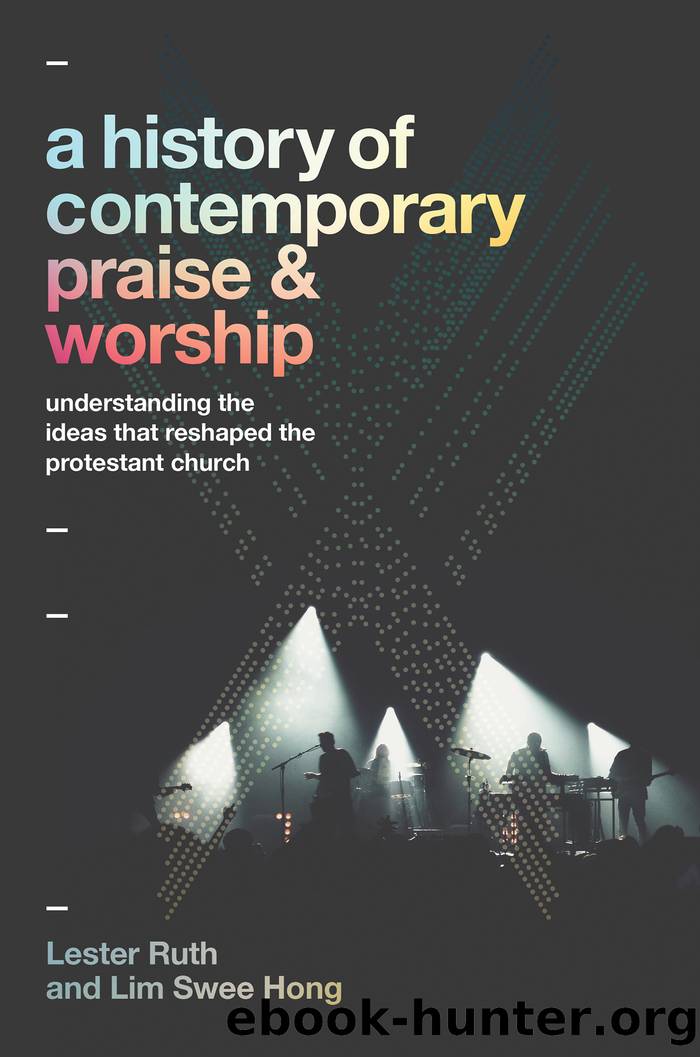A History of Contemporary Praise & Worship by Lester Ruth

Author:Lester Ruth
Language: eng
Format: epub
Tags: Worship/History;Public worship—History—20th century;REL055020;MUS009000;REL015000
Publisher: Baker Publishing Group
Published: 2021-10-20T00:00:00+00:00
A New Gap to Consider: The Youth
Aimee Semple McPherson was born in 1890 and died in 1944. Over approximately the same time as her span of life, a cultural development occurred that would significantly influence liturgical pragmatism in the years after her deathânamely, widespread understanding of a âgenerationâ as a cohort determined by age. This sense of âgeneration,â formally defined by sociologists but eventually spreading as a common notion outside that academic guild, grouped people born within a certain time frame as a cohort with similar experiences and perspectives.35 In other words, as a general framework for understanding society, North Americans had begun to group themselves based on when they were born. As one historian stated, this developing sense of generation implied that society was âdivided into compartments or worlds defined by age.â36
Theologians of Contemporary Worship likewise picked up on this approach to generation and incorporated it into their contemplation of a gap between worship and people. As we have seen, these sorts of gap thinkers have always looked for how the churchâs worship was ineffective and why it was so. Thus, these bridge-the-liturgical-gap thinkers have had a propensity to look at people and to consider them closely. This spreading sense of generation gave these thinkers a new lens through which to contemplate what the problem might be: the churchâs worship was ineffective because it did not connect with a certain generation defined by age. This line of thought became a recurring refrain after the mid-twentieth century.
What contemplating specific generations with respect to worship meant for liturgical pragmatism was the rise of age-based targeting to find a way to eradicate the gap. The problem was no longer conceived as just a gap between the church and people in generalâwhether the âlostâ or the unchurched or the boredâit could now be thought of as an age-related gap. For the history of Contemporary Worship, this approach that sought to connect worship with specific generations had a major impact and was a major development. Consequently, in the mid-twentieth century the subterranean waters of the river that became Contemporary Worship bubbled up again but in a new form: ways of worship aimed at youth as the critical generation.
That pragmatic Christian thinkers would focus on youth was not surprising: the early sociologists who developed the notion of âgenerationâ had shared the same focus. For example, Karl Mannheim, who wrote the seminal essay on the topic, had described generational location as involving certain definite modes of behavior, feeling, and thought and highlighted the time of youth as the key period in which social generations are formed.37 These sociologists were reflecting a sense that had grown in the late nineteenth century of âgenerationâ meaning someone of the same age. As the nineteenth century came to a close, the term âgenerationâ increasingly evoked a sense of a dichotomy between the older generation (i.e., adults) and the generation neither adults nor children (i.e., youth). This sense of a binary between adulthood and youth grew as industrialization enabled more people
Download
This site does not store any files on its server. We only index and link to content provided by other sites. Please contact the content providers to delete copyright contents if any and email us, we'll remove relevant links or contents immediately.
Joan of Arc by Mary Gordon(3981)
Victory over the Darkness by Neil T. Anderson(2777)
The Gnostic Gospels by Pagels Elaine(2441)
Devil, The by Almond Philip C(2245)
The Nativity by Geza Vermes(2150)
The Psychedelic Gospels: The Secret History of Hallucinogens in Christianity by Jerry B. Brown(2094)
Going Clear: Scientology, Hollywood, and the Prison of Belief by Lawrence Wright(1910)
Going Clear by Lawrence Wright(1893)
A TIME TO KEEP SILENCE by Patrick Leigh Fermor(1810)
Barking to the Choir by Gregory Boyle(1746)
Old Testament History by John H. Sailhamer(1731)
Augustine: Conversions to Confessions by Robin Lane Fox(1711)
A History of the Franks by Gregory of Tours(1654)
A Prophet with Honor by William C. Martin(1645)
The Bible Doesn't Say That by Dr. Joel M. Hoffman(1621)
The Knights Templar by Sean Martin(1609)
by Christianity & Islam(1577)
The Amish by Steven M. Nolt(1507)
The Source by James A. Michener(1501)
